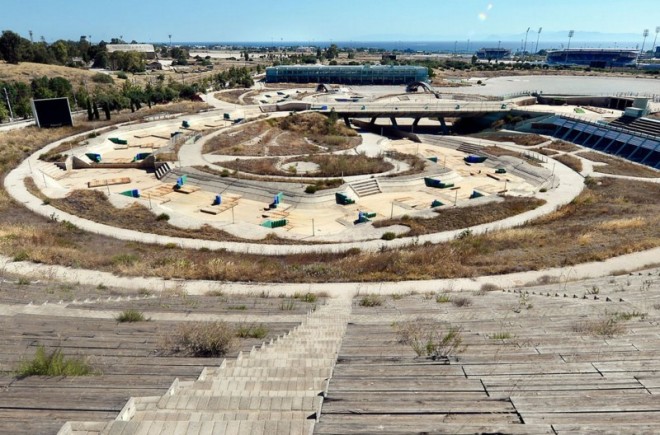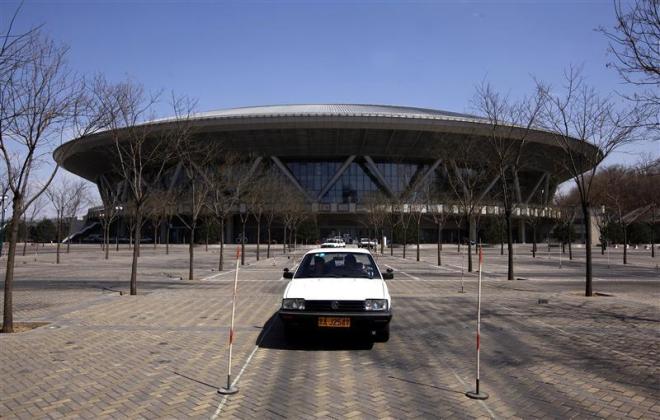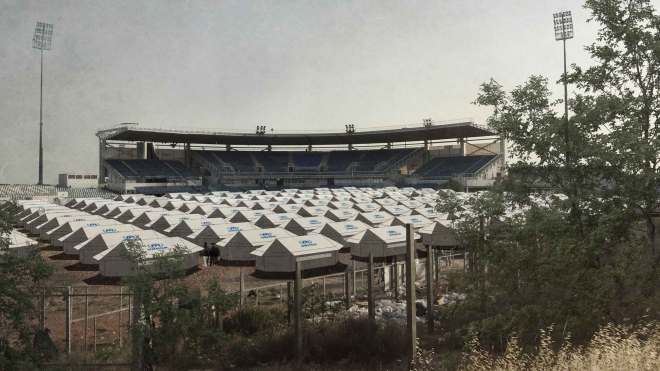Abstract
This paper puts forward a new interpretation for the monumental earthworks recorded across the continental masses of the planet Earth, dating to the Middle Anthropocene period. This study seeks to refute previous interpretations in favour of a new theory, namely that these monumental structures represent the material remains of symbolically charged ritual events which can be seen as an expression of societal stress in a period of rapid transitions and environmental decline.

Introduction
Monumental constructions and earthworks have been documented on the outskirts of a number of large conurbations dating to the Middle Anthropocene period (late 2nd/early 3rd millennium AD) in widely separated parts of continental Earth. The mystery surrounding these structures has been enhanced by the paucity of the contemporary documentary record due to the Great Solar Storms of the mid-3rd millennium AD, which erased most of the predominantly digital records of the period, leaving only fragmentary texts from which to reconstruct the contemporary literary, political and economic milieu.
The monuments have in common a massive scale but show a variety of shapes and functional forms. Some are simply banks of spectator seating arranged amphitheatrically around flat areas and circuits of varying shapes and dimensions; others contain trenches and water-filled lustral basins of unknown purpose; the most puzzling ones include elaborate curvilinear ditch-and-bank earthworks, combined with mysterious mounds (see above). They were often located on the margins of existing habitations, after the land was extensively cleared, perhaps in a ritual purging, removing all traces of previous activity.

Stylistically, the structures are defined by a collection of common traits which has come to be known as the “International Startchitect Koiné”: exaggerated monumentality, the use of rare materials and elaborate construction techniques, the labour-intensity of the construction, the dominance of form over function are all features of this universal style, which becomes more elaborate as the period progresses. The structures could accommodate several thousand people and are believed to have taken years to construct using imported labour that may have been drawn from lower castes, forced or indentured, and there is some evidence to suggest that the grizzly custom of human foundation sacrifice was practiced to secure the buildings’ foundations. Mysteriously, most of the structures appear to have been put to very limited use, as attested by the unusually light wear patterns in their furnishings.

The function of the monuments has puzzled archaeologists and the fascinated the general public for generations. Earlier scholars posited that such structures were the remnants of extra-terrestrial civilisations, so alien did they appear within the human landscape. However, through recently published cross-cultural studies with our extra-terrestrial colleagues we are now able to discount these rather fanciful theories. The argument that the monuments are “visible from outer space” is in our view an ex post fact rationalisation reflecting an Earth-centric bias in the scholarship of the time. Another interpretation suggested that they were defensive structures; however, evidence of damage by artillery fire and mass burials has been shown to post-date the initial phase of their use. We use the fragmentary documentary evidence in conjunction with the archaeological remains to propose a radically different interpretation that does not require the presence of alien visitors, but rather explains the extraordinary structures in the context of complex ideations and value systems of contemporary societies, as they sought to respond to increased global interaction, social pressures and rapid climatic change.
Towards an alternative interpretation
Previous scholarly attempts to explain the purpose of these structures have tended to focus on functionalist interpretations, for example that they were defensive in nature, or that they were initiated with the aim of mobilising labour for productive purposes, on the model of Amish barn-raisings. We have found very little evidence to support such theories. Instead, we would argue that the immense mobilisation of labour and resources for ephemeral or even single-use purposes have more in common with the types of practices that anthropologists refer to as “total prestations” or “tournaments of value”, systems of gift-giving with political, religious, kinship and economic implications. These are are marked by the competitive exchange of gifts, in which gift-givers seek to out-give their competitors so as to capture important political, kinship and religious roles. Examples of this include the “potlatches” of the Pacific Northwest Coast of Canada, during which chieftains competed to distribute gifts such as blankets, animal skins and ritual instruments, and enhanced their social standing by ritually destroying them in large bonfires. In contrast with western industrial economies, status in these societies was achieved in such events not by accumulating wealth, but by giving it away or destroying it in a conspicuous manner.

It may be seen as a paradox that such “primitive” practices could be found in “advanced” human societies. It is useful to bring to bear here the documentary record, which, though fragmentary, offers glimpses into a sophisticated ideational construct surrounding these mysterious material remains. Studies have shown that the official religion of the Middle Anthropocene centred on the dogma of “economic rationality”, which at the height of the construction of these buildings had entered the phase known as “late capitalism”. Within this value system, the driving force was the individual’s (or group’s) maximisation of material wealth by the most efficient means. This appears to be borne out by meticulous administrative documentation relating to the preparation and building of the structures. In these documents, the priestly castes frequently invoke religious terms such as “cost/benefit” and “economic impact analysis” in order to present the projects in an “economically sound” light.
At the same time, a seemingly contradictory body of evidence associates the very same projects with metaphysical concepts such as “regeneration”, “sustainability” and “legacy” – a clear nod to the mystical Dionysiac concept of death and rebirth. It is clear from the literature that this belief system viewed the structures as part of a cosmogonic ritual aimed at summoning up “world peace”. An apocryphal text known as the “Olympic Spirit” exhorts participants “to build a peaceful and better world […] to promote tolerance and understanding in these increasingly troubled times in which we live, to make our world a more peaceful place”.
Despite being mutually contradictory and internally inconsistent, these belief systems seem to have coexisted in tandem for over a century, and were surprisingly resilient to critique. We have, for example, ample contemporary evidence of criticism that the structures and the rituals associated with them did not in fact deliver the promised economic salvation but instead guaranteed balance sheet damnation, while others pointed out that there was no correlation between the rituals and world peace, or that the events resulted in “debt, displacement, and militarisation of public space” and some accused the elders entrusted with organising them of corruption. It is thought that such criticism was regarded as heretical and its exponents punished severely, but the fate of the critics is not recorded.

Little is known about what actually took place within the monumental structures. From the associated waste dumps it is clear that ritual feasting played a great part in the activities. With time, the paraphernalia associated with consumption became increasingly formalised, and ritual vessels more often than not bear the mysterious “Golden Arches of Consecration”. It is also known that those attending the rituals partook of a beverage served in a distinctive steatopygous glass vessel, whose recipe was closely guarded in a temple vault – perhaps an aphrodisiac or a fertility elixir. Each ritual site seems to have been presided over by a distinct monstrous deity or anthropomorphic animal spirit (above), clearly intended to induce a holy terror in the participants. Some claim to have found evidence of athletic contests, however we believe that such evidence is too scant to merit consideration here.

The resilience of the belief system that fuelled these “tournaments of value” is further evidenced by the respect with which the monuments were often treated after their initial construction. Although subsequent generations appear to have forgotten the original purpose of the structures, they often venerated them as sacred ruins by preserving them intact and allowing the land around them to lie fallow. It is likely that only the more prosperous hosts that were able to do this, while others were forced to adapt and reuse the structures as their circumstances dictated. Occasionally, the structures were put to temporary use, as is evidenced in Phase VIIb of the Hellenikon Rhomboid Structure which appears to have been repurposed as a temporary habitation site during the “great migration” of the early 21st century AD (below).

An ancient precedent?
Recently, scholars have suggested that the structures and and the rituals associated with them find a direct antecedent in religious festivals dating two and a half millennia earlier, and have adopted the term “Olympic” to describe them, alluding to the largest of these earlier festivals. However, despite sharing many features with these earlier practices, the long hiatus between the two sets of events leads us to posit that we are in fact dealing with a Hobsbawmian “invented tradition”: by adopting self-consciously archaising practices, emergent elites seek to legitimise their status by demonstrating their continuity with a quasi-mythical past.
It is suggested here that such practices arose as a way of bolstering a fragile global hierarchy and establishing social cohesion in an era when a rise in the overall living standards on the planet was accompanied by increased competition for resources and the looming threat of catastrophic climate change. Testing this hypothesis, however, is beyond the scope of the current paper.
Further documentation of the mysterious structures and their history of re-use here, as artillery defences and as a prison.
Further reading on the future archaeology of the Middle Anthropocene: “Our Piece of Paradise: Patterns of Coastal Habitation…”
IMAGES: Athens 2004 canoe/kayak venue by Milos Bicanski; Athens 2004 training pool by Associated Press; London 2012 Aquatics Centre by Zaha Hadid Architects; Wenlock and Mandeville, the London 2012 Olympic Mascots via Rainbow Productions; Beijing 2008 velodrome by REUTERS/David Gray; Athens 2004 baseball stadium by Jai Mexis & Partners via This American Life.